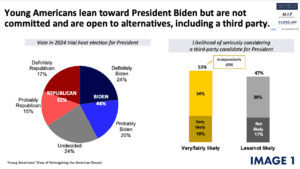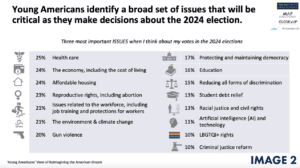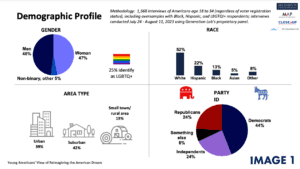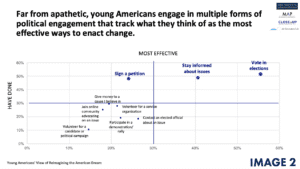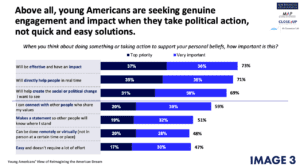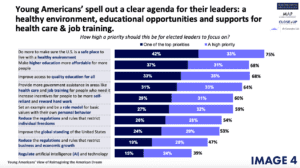
What is the Child Tax Credit Proposal?
There is an ongoing bipartisan effort in Congress to pass legislation that would provide financial support for families with young children. The bill would allow parents and guardians to receive a larger tax credit of up to $2,000 with the entire credit being refundable. This would provide some families with an additional $700-$1,400 dollars each year.1
The House of Representatives has already passed the bill. The Senate is now considering it.
WATCH: “What’s in the Bill to Expand the Child Tax Credit?” from PBS
What Would the Child Tax Credit Bill Do?
According the Center on Budget and Policy Priorities (CBPP), this bill would benefit roughly 16 million children and would bring approximately 500,000 children out of poverty. In the first year:
- Overall, more than one in five children under 17 would benefit from the expansion.
- More than one in three of all Black and Latino children under 17 would benefit.
- Three in ten of all American Indian and Alaska Native children under 17 would benefit.
- One in seven of all white and Asian children under 17 would benefit.2
The Child Tax Credit bill would impact different families in unique ways according to income, the number of children they have, and whether or not they are single-parent families. According to the CBPP, these are some examples of the ways in which families could benefit:
- A single parent with two children who earns $13,000 working part time as a home health aide would see their credit double (a $1,575 gain) in the first year.
- A single parent with two children who earns $22,000 as a child care worker would gain $675 in the first year.
- A married couple—with one parent earning $32,000 as a nursing assistant and the other parent staying home to take care of their three young children—would gain $975 in the first year.3
READ: “Child Tax Credit Proposal: Impacts by the Numbers” from the Center on Budget and Policy Priorities
What Are Legislators Saying About the Bill?
Sen. Ron Wyden (D-Ore.), the chairman of the Senate Finance Committee and a lead author of the bill, said, “Fifteen million kids from low-income families will be better off as a result of this plan, and given today’s miserable political climate, it’s a big deal to have this opportunity to pass pro-family policy that helps so many kids get ahead.”4
Sen. Mike Crapo (R-Idaho), the ranking member of the Senate Finance Committee, said that the overall bill does not yet have his support but he is working with committee members to make changes. “We have not resolved everything yet,” he said. “I hope we are able to get a bill, and I’ve been working on this bill for three years.”5
Rep. Danny Davis (D-Ill.) expressed frustration that the bill doesn’t do more. “You know I’ve been told that a half a loaf is better than none,” he said. “This isn’t even half a loaf, but I’m going to vote for it because our families and businesses need help.”6
“The tax bill we are considering today contains several wins for families and our economy, but one piece falls short. The child tax credit expansion would still leave behind millions of kids in families that need it the most,” said Rep. Suzan DelBene (D-Wash.). “I will still continue leading the effort to fully expand the child tax credit.”7
Rep. Rosa DeLauro (D-Conn.) also expressed anger at the bill not going far enough. “This bill provides billions of dollars in tax relief for the wealthy, pennies for the poor,” she said. “Big corporations are richer than ever. There is no even split.”8
Some lawmakers have argued that the bill goes too far. For example, Rep. Thomas Massie (R-Ky.) said, “What is a refundable tax credit? It’s welfare by a different name. We’re going to give cash payments, checks, to people who don’t even pay taxes.”9
What Are Others Saying About the Bill?
Steven Hamilton, a professor of economics at The George Washington University, said, “We know that the child tax credit is an incredibly effective, well-targeted mechanism for delivering relief to families with children.”10
Responding to criticism that the bill is too small, Nikhita Airi of the Urban-Brookings Tax Policy Center said, “Even a small boost of income can pay really big dividends.”11
The American Enterprise Institute, a policy think tank, argues that the Child Tax Credit bill would lead to people leaving the workforce because of the tax credit. They argue that because the bill does not have a work requirement, some families may earn more from the tax credit than from work, which will lead people already in poverty to give up on jobs that might eventually help them increase their earnings.12
What Comes Next?
The bill now goes to the Senate, and it may be sent back to the House if significant changes are made. As the arguments outlined above show, there is still work to be done to develop a bill that can pass the Senate. This is a good time for the public to make their voices heard and express support for or opposition to the bill by reaching out to their members of Congress.
CONTACT: Reach out to your elected officials about this or any other issue!
Discussion Questions
- Is poverty an issue in the community where you live? What evidence do you see of poverty, especially child poverty, in your area?
- Which arguments about this bill do you find most persuasive? Do you think it is a good bill? Does it go too far? Not far enough?
- What do you think should be the role of the federal government in trying to reduce or eliminate poverty?
- If you were talking to a member of Congress about this issue, what would you say to them? What would you want them to do?
As always, we encourage you to join the discussion with your comments or questions below.
Close Up is proud to be the nation’s leading nonprofit civic education organization, working with schools and districts across the country since 1971. If you would like to partner with us or learn more about our experiential learning programs, professional development, or curriculum design and consulting, contact us today!
Sources
Featured Image Credit: Erin Woodiel/Missouri Independent
[1] ABC 7 Chicago: https://abc7chicago.com/child-tax-credit-bipartisan-proposal-ron-wyden-jason-smith/14375687/
[2] Center on Budget and Policy Priorities: https://www.cbpp.org/research/federal-tax/child-tax-credit-proposal-impacts-by-the-numbers
[3] Ibid.
[4] Roll Call: https://rollcall.com/2024/01/16/tax-panel-leaders-clinch-deal-on-child-credit-business-breaks/
[5] Ibid.
[6] ABC 7 Chicago: https://abc7chicago.com/child-tax-credit-bipartisan-proposal-ron-wyden-jason-smith/14375687/
[7] American Enterprise Institute: https://www.aei.org/articles/ctc-expansion-rooted-in-desire-to-roll-back-work-based-welfare/
[8] Ibid.
[9] Associated Press: https://apnews.com/article/child-tax-credit-house-republicans-speaker-johnson-4da25a4188ad27693e9d8755e7481b76#:~:text=WASHINGTON%20(AP)%20%E2%80%94%20The%20House,gives%20lawmakers%20on%20both%20sides
[10] CNBC: https://www.cnbc.com/2024/02/01/child-tax-credit-expansion-could-benefit-millions-of-families.html
[11] Ibid.
[12] American Enterprise Institute: https://www.aei.org/articles/ctc-expansion-rooted-in-desire-to-roll-back-work-based-welfare/
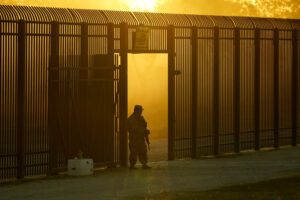 On Sunday, February 4, a bipartisan group of senators unveiled a compromise bill intended to address border security concerns and to provide further funding for Ukraine’s military defense against Russia.1 In this post, we will examine the immigration-related contents of the compromise legislation and explore different perspectives about the border security bill.
On Sunday, February 4, a bipartisan group of senators unveiled a compromise bill intended to address border security concerns and to provide further funding for Ukraine’s military defense against Russia.1 In this post, we will examine the immigration-related contents of the compromise legislation and explore different perspectives about the border security bill. Amidst the mosaic of national debates surrounding climate change, economic justice, and public health, there is a growing focus on the intersection of these issues and the design of our communities. The overwhelming majority of U.S. households own at least one vehicle, and the number of vehicles registered in the United States has continued to rise in recent years.1 Some argue that car dependency is a symptom of the design of American cities, others argue that it’s the cause.
Amidst the mosaic of national debates surrounding climate change, economic justice, and public health, there is a growing focus on the intersection of these issues and the design of our communities. The overwhelming majority of U.S. households own at least one vehicle, and the number of vehicles registered in the United States has continued to rise in recent years.1 Some argue that car dependency is a symptom of the design of American cities, others argue that it’s the cause.
 In the weeks since the Hamas terrorist attacks of October 7, Israel has conducted a military campaign with the stated goal of eradicating Hamas as both a military and governing organization.1 The death toll in Gaza currently stands at around 22,000 Palestinians and 170 Israeli soldiers, in addition to the more than 1,200 people Hamas killed on October 7.2 While further negotiations over a second ceasefire are ongoing (as of January 3, 2024), officials in the United States and around the world are also concerned about broader regional and global conflict boiling over.3 Many in the United States share these concerns.4
In the weeks since the Hamas terrorist attacks of October 7, Israel has conducted a military campaign with the stated goal of eradicating Hamas as both a military and governing organization.1 The death toll in Gaza currently stands at around 22,000 Palestinians and 170 Israeli soldiers, in addition to the more than 1,200 people Hamas killed on October 7.2 While further negotiations over a second ceasefire are ongoing (as of January 3, 2024), officials in the United States and around the world are also concerned about broader regional and global conflict boiling over.3 Many in the United States share these concerns.4 As part of our ongoing series centered on the Israel-Hamas conflict, this post will review the U.S. foreign policy decisions.
As part of our ongoing series centered on the Israel-Hamas conflict, this post will review the U.S. foreign policy decisions. 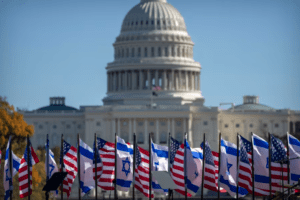 This is the first in a series of posts that will explore complex domestic policy, foreign policy, and global issues connected to the Israel-Hamas conflict. In the United States, there has been significant discussion and debate about what to do, both in terms of foreign policy and on the domestic front. In this series, we will examine rising antisemitism and anti-Muslim hate in the U.S., evaluate what the United States could and should do in the Middle East from multiple perspectives, and examine the impact the conflict is having on the United States as it navigates issues in the region and around the world.
This is the first in a series of posts that will explore complex domestic policy, foreign policy, and global issues connected to the Israel-Hamas conflict. In the United States, there has been significant discussion and debate about what to do, both in terms of foreign policy and on the domestic front. In this series, we will examine rising antisemitism and anti-Muslim hate in the U.S., evaluate what the United States could and should do in the Middle East from multiple perspectives, and examine the impact the conflict is having on the United States as it navigates issues in the region and around the world.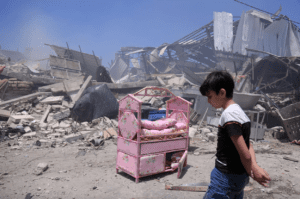 The Hamas Attack Launches
The Hamas Attack Launches